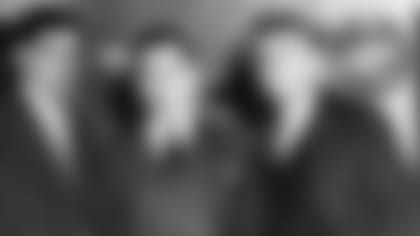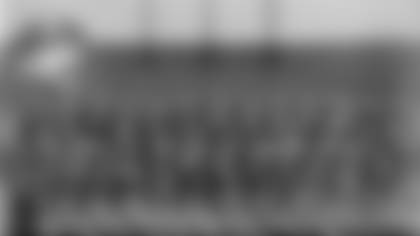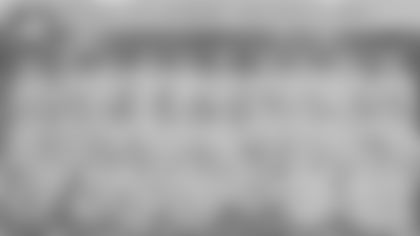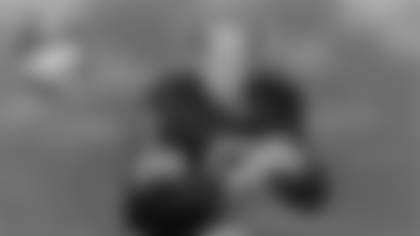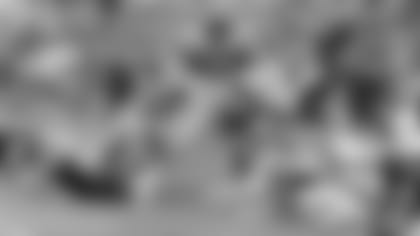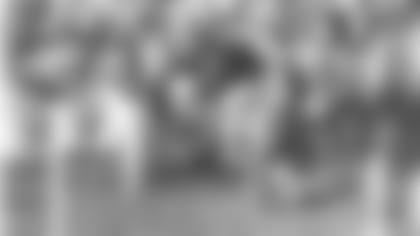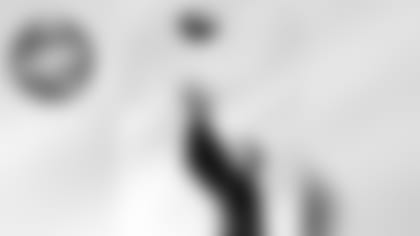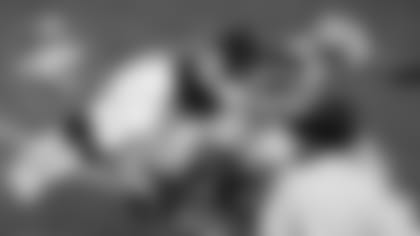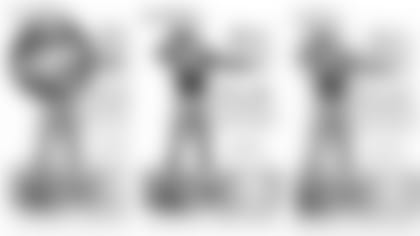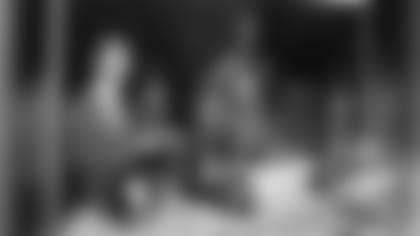Leonardo from Las Vegas, NV
What was Curly Lambeau's record when he coached against the Packers? How was he received by the crowd when he returned to Green Bay? Was there any evidence of the animosity between Lambeau and the Packers in the years between his departure and his death?
Lambeau coached in the NFL for four years after he left the Packers and returned to Green Bay three times, all for exhibition games. Lambeau coached the Chicago Cardinals in 1950 and for 10 games in 1951, and lost in the preseason both years at old City Stadium by the same score, 17-14. He also coached Washington in 1952 and '53 and, and beat the Packers in Green Bay, 13-6, in a preseason game the second year.
Even though Lambeau's departure in February 1950 followed months of bitter in-fighting between him and certain members of the franchise's board of directors, the Packers moved quickly to try and get him to play an exhibition game in Green Bay once he resigned to take the Cardinals' job. As you may know, the Packers were desperately in need of cash.
When club president Emil Fischer announced on April 6, 1950, that Lambeau would be bringing his Cardinals to Green Bay four months later, he was overjoyed. "We have been working on arrangements for this game for some time," Fischer said, "and from the beginning we wanted it for Green Bay as a present to our loyal Packer fans. We think it will be the beginning of the greatest football bill of fare ever offered in this area, and we believe we will pack the stadium."
Six days later, the Packers launched their 1950 stock sale and raised roughly $100,000 before the August kickoff, enough to continue operating. So they weren't quite as desperate when the game drew 20,156 fans, about 5,000 less than capacity.
While the Green Bay City Council warmly welcomed Lambeau and presented him with a plaque in appreciation of all he had done for the city in a pregame ceremony, his former players sought revenge on the field.
The Packers played their first exhibition against Cleveland on Aug. 12 in Toledo and Lambeau was there to scout the game. The Browns crushed the Packers, 38-7, and Art Daley of the Green Bay Press-Gazette either overheard or learned that within minutes after the game Lambeau turned to Bob Snyder, one of his assistants in Green Bay in 1949 and also an observer that night, and said, "Just like 1949, no effort."
Clearly, Daley must have spread the word as soon as he reached the locker room. "The postgame statement swept through the Packer dressing room like wildfire," Daley wrote. "The Packers were boiling." Daley also quoted an anonymous player, who said, "I thought we heard the last of him (Lambeau) when he quit."
The day of the game, Daley's lead to his game preview read, "Green Bay Packers vs. Curly Lambeau!" Daley subsequently referred to the game as the "Battle of the Century."
As for the fans, Daley never wrote anything about them booing, but said they were "on" Lambeau most of the night in the cozy confines of City Stadium. After one Packers score, Daley wrote that a fan "hooted" at Lambeau, "You sorry now Curly?"
There was much less fanfare on Lambeau's other two visits to Green Bay for preseason games and even less when he faced the Packers for the only time in the regular season. That game was played Oct. 5, 1952, at Milwaukee's Marquette Stadium, and drew 9,657 fans.
When the Packers won 35-20, it gave Lambeau a career record of 0-1 against his former team.
Was the animosity that developed between Lambeau and the Packers evident during the 15 years he lived after resigning as coach?
Even when he was coaching and winning in Green Bay, Lambeau had his supporters and enemies. But there was never any polling done to determine how public opinion swayed from his years as coach to those as ex-coach, so I'd only be guessing.
On one hand, Lambeau skipped the stadium dedication game in 1957. On the other hand, eight years later fans essentially forced the city and the Packers to rename the stadium in his honor. On one hand, two of his worst enemies, board members Jerry Clifford and Dr. W.W. Kelly, died within roughly two years after Lambeau departed. But a decade later, Lombardi became one of Lambeau's archenemies and skipped his funeral.
If you're interested in reading more about your last question, I addressed the issue at times in my recently published book.
Peter from Irvine, CA
I've frequently heard that the Packers have a particularly strong following in Hawaii. Perhaps it has to do with the Packers' trip to Hawaii in December 1932 through January 1933 when they won two football games and a basketball game against local competition. Can you share any other insights as to how that trip came about?
If the Packers have a large fan base in Hawaii, it's certainly not surprising. And not only because of that trip, but also the 1966 Packers-Bears game at Lambeau Field. It was played Nov. 20 and was the first professional football game to be telecast live in Hawaii. The game was transmitted from Lambeau to Brewster Flat, Wash., via normal communication, then bounced off a satellite in the Pacific Ocean to Paumalu, Hawaii, and distributed to the islands from there. The satellite was launched almost a month earlier from Cape Kennedy.
In 1966, the Packers won their fourth of five NFL championships under Lombardi, Bart Starr had his best season and the Packers beat the Bears that day, 13-6. I'm guessing there are people in Hawaii who might still remember the day.
As for the 1932 trip, it's a great story with a lot of elements. It was organized by Johnny Blood as a barnstorming tour, took two months and covered 10,000 miles, in all. The Packers rode trains from Green Bay to Los Angeles, where they boarded the S.S. Mariposa, a luxury ocean liner, for the trip to Honolulu.
On Dec. 26, four days after their arrival, the Packers beat the Kamehameha Alumni, 19-13. On Jan. 2, 1933, they beat the McKinley School Alumni, 32-0. Nine days later, the Packers left Hawaii but their barnstorming tour continued with two more games on the West Coast.
Blood wrote and cabled stories from Honolulu to the Press-Gazette and there was even a radio hookup delivered to the fans back home. Play-by-play details were telephoned from Honolulu Stadium to the local offices of R.C.A., sent by wireless across the ocean to San Francisco, relayed by telegraph from there to Green Bay and broadcast over WHBY, the St. Norbert College radio station at the time.
Days before the Packers departed, a cablegram was received in Green Bay from Dr. R.A. Herron, a former intern at Bellin Memorial Hospital, and Dr. K.L. Chang, a former classmate of a Green Bay dentist. The two doctors wired from Honolulu, "We are informed Green Bay Packers will play here Christmas. If you have friends on team advise. We will extend special courtesies. Aloha."
Again, I wrote about some of the side stories in the Milwaukee Road chapter of the **Packers Heritage Trail book**. There's an interesting story about how the trip led to Lambeau's first divorce.
Jeff from Neenah, WI
Prior to 1963 when the offices were built at the north end of the stadium, were the locker rooms located on the south end of what is now Lambeau Field? I noticed in the highlights of the 1961 NFL Championship, the Giants and Packers both emerged from the south end.
Yes, when what was originally named Green Bay City Stadium opened in 1957, both locker rooms were in a rather small, cement-block building at the south end. The Packers office building was still on Washington Street in downtown Green Bay and remained there until a new administration building with new dressing rooms was completed at the north end before the start of the 1963 season.
At that point, the old cement-block building at the south end was converted into public restrooms.
Dennis from Ottawa, IL
Which individual had the longest connection with the Packers?
I believe it was either Lee Joannes or Charlie Mathys.
Lee Joannes served 57 years, plus two more as a director emeritus. He was elected to the board of directors and executive committee when the Green Bay Football Corporation was created in 1923 and the Packers became publicly owned. Joannes' last year as an active director was 1980 before he became a director emeritus until his death in 1982. He served on the executive committee for 34 of those years and as president from 1930 to 1947.
The difference between the tenures of Joannes and Mathys might have been days, but I don't have the exact date when Mathys was elected to the board. He played quarterback for the Packers from 1922-26, then was elected to the board in either 1927 or '28 and served until 1980. That was a total of either 57 or 58 years. Like Joannes, Mathys also was a director emeritus for close to three years before his death in 1983.
Bud Jorgensen served on the football side for 46 years as a trainer and property or equipment manager, although he made his first road trips in 1924 as basically a gofer to then property man and trainer Pat Holland. Jorgensen spent his final two years, 1969-70, assisting Domenic Gentile, his replacement as trainer.
Dave Hanner spent 44 years with the Packers as a player, coach and scout; and Red Cochran, 42 as a coach and scout.
Jack from Avon, IN
I remember attending a Packers game - I believe an exhibition - at Marquette Stadium. It was a night game. Each fan was given a candle as they entered the stadium and at halftime all the lights were turned off and we all lit our candles. Can you add any clarification? I've attended games at old City Stadium, Lambeau, State Fair Park, Marquette Stadium and County Stadium so some of them are hard to recall and that's why I appreciate your blogs so much. I thought the game was in the 1940s, but you say the Packers played at Marquette Stadium only in 1952.
Thanks for being a loyal reader and that's quite a resume as a fan. I suspect you are in extremely select company.
I've tried to pinpoint the game, but can't find a definitive answer. In 1952, the Packers played a night exhibition game against the New York Giants at Marquette Stadium before playing three regular-season home games with 1:30 kickoffs.
My educated guess is that you're talking about the exhibition against the Giants. That was just the third Midwest Shrine Game and the Shriners always put on a glitzy halftime show. Even when I was covering the Packers in the 1970s and '80s, I vaguely remember the stadium going dark at halftime while the Shriners performed. I couldn't find anything in the Milwaukee or Green Bay papers to confirm the candlelight ceremony, but kickoff was 8 p.m.
My other hunch didn't pan out. In 1942, the Packers played a benefit exhibition game against the Western Army All-Stars at Marquette Stadium, but it was a Sunday afternoon game.
Rick from Shawano, WI
What were the ticket prices for sideline seats, circa 1957-60?
When the stadium opened in 1957, a sideline season ticket between the goal lines was $14.25. That was for the three regular-season games played in Green Bay that year. A season ticket in the south end zone was $9.90 and in the north end zone, $6.75. Kids tickets in the northeast corner cost $2.25, 75 cents per game.
Somebody asked me once why the north end zone seats were cheaper and I wasn't sure. I've since found the answer: Fans sitting in the north end zone had to look into the sun for at least portions of games. Kickoff time in 1957 was 1:05 p.m.
In 1960, Lombardi's second season, the Packers played four regular-season home games in Green Bay and prices were increased. At that point, the stadium had yet to be expanded from its original 32,154 seats and was still not selling out on a regular-season basis.



